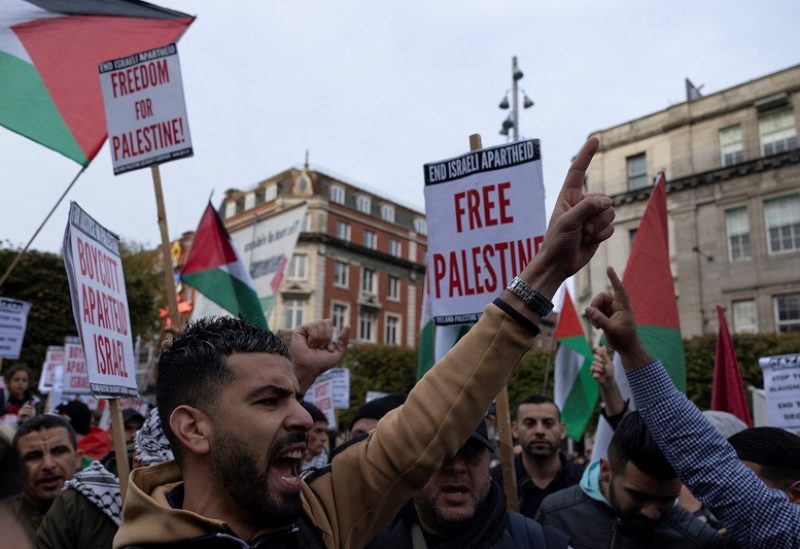
Demonstrators rally during a 'Stand with Palestine' protest in solidarity with Gaza, in Dublin, Ireland October 11, 2023. REUTERS/Clodagh Kilcoyne
Israel has been preparing for a ground assault on the Gaza Strip for several days, following a relentless barrage of rockets and missiles from land, sea, and air. In response, Hamas and its military arm have not ceased their field confrontations, involving repeated incursions towards settlements and a substantial volume of rockets that have strained the Iron Dome system, according to an informed source.
The source also recalls the events surrounding the operation in which “Hamas” stunned Israel with twin attacks: one involving infiltrating Israeli army camps in the vicinity of the Gaza Strip, and the other penetrating settlements in the Gaza periphery. Israel suffered significant human losses, including fatalities, injuries, and prisoners. This marked an unprecedented development for the Zionist entity.
Israel and its army have been unable to regain the initiative, which they lost during and after the operation, lasting approximately 8 hours. After waking up to the situation, Israel initiated a fiery military operation but was unable to halt the rocket attacks by the military factions affiliated with Hamas, as well as the repeated incursions towards settlements. Perhaps the most concerning aspect is their success in disrupting air traffic.
Conversely, through monitoring international stances, Israel received significant support, particularly during the initial days of the operation. This support was reinforced by the visual evidence demonstrating how prisoners and casualties were dealt with. Additionally, “Hamas” is designated as a terrorist organization, and leaked reports have mentioned an Iranian decision made in Beirut, which set the movement’s “zero hour.”
However, according to the source, it appears that Hamas will not receive sufficient support from its allies to confront the Israeli ground invasion of Gaza. Gaza seems to be heading into a “scorched earth” scenario after cutting off all vital supplies. The skirmishes taking place at its southern borders, handled by Hezbollah through rocket attacks targeting its centers, soldiers, and vehicles, are likely to remain confined to a mutual exchange of fire. It is unlikely to escalate further and serves as a form of pressure on another front, causing confusion.
As for the gatherings in the occupied Golan Heights and discussions of the potential for the front to ignite after the recent rocket exchanges, the source believes that this region could become a broader stage for exerting pressure on Israeli military operations in Gaza. This is due to its extensive geographical advantage, hosting several militias, notably the Hussein Brigade affiliated with Iran and Hezbollah, the Fourth Division of the Syrian army, the Al-Nujabaa Movement militia, all operating under the supervision of the Iranian Revolutionary Guard.
For these reasons, the source believes that the Golan Heights front could be the least damaging refuge within the Iranian axis to deal with Israeli attacks. Through this front, they can address Israeli offensives, thereby sparing southern Lebanon from a fate similar to what is happening in Gaza. Hezbollah cannot afford to bear the burden of a crisis that its environment cannot endure, given the losses it sustained in 2006, amid internal opposition to dragging Lebanon into such a situation. There is also a cooling of relations with Arab and Gulf states, which would not allow for the reconstruction of areas that may be destroyed, considering the experiences some of these countries went through due to Hezbollah’s support and involvement with parties hostile to these nations, whether through military support or hosting and training them.
What can be inferred is that despite Israel suffering significant losses not seen since 1973, it will not cease its mission, considering the success of the operation as a means to halt its existence. This also counters the ambitions of Prime Minister Benjamin Netanyahu, who publicly expressed his intent, including during the 78th session of the United Nations General Assembly held in September last year. During this session, he presented a map that included a reference to the existence of a Palestinian state. The blue color representing Israel dominated the part that encompassed the entire occupied West Bank, including the Gaza Strip.